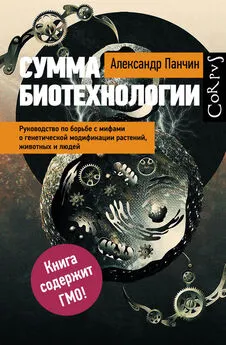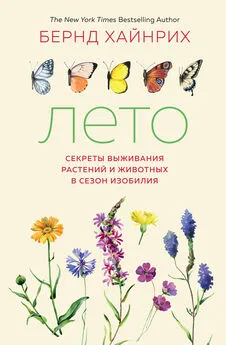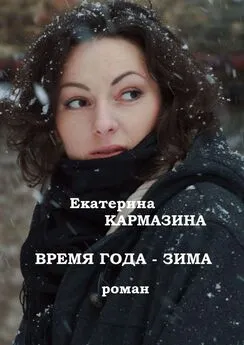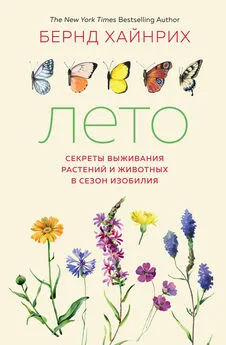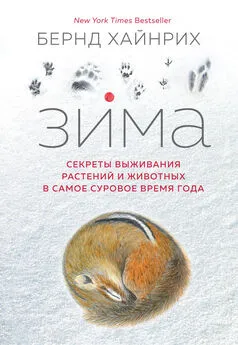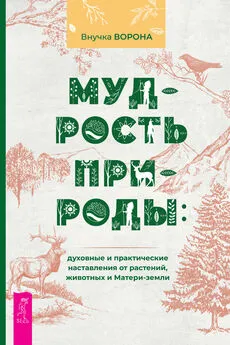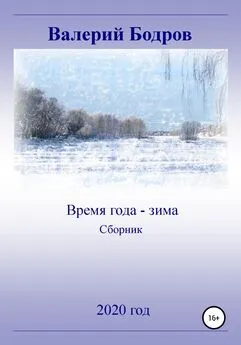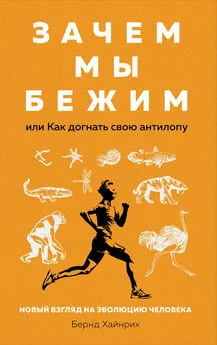Берндт Хайнрих - Зима: Секреты выживания растений и животных в самое суровое время года
- Название:Зима: Секреты выживания растений и животных в самое суровое время года
- Автор:
- Жанр:
- Издательство:Литагент Аттикус
- Год:2021
- ISBN:978-5-389-20228-3
- Рейтинг:
- Избранное:Добавить в избранное
-
Отзывы:
-
Ваша оценка:
Берндт Хайнрих - Зима: Секреты выживания растений и животных в самое суровое время года краткое содержание
В формате PDF A4 сохранен издательский макет.
Зима: Секреты выживания растений и животных в самое суровое время года - читать онлайн бесплатно ознакомительный отрывок
Интервал:
Закладка:
_. (1982). Survival of frogs in low temperature // Science. 215. P. 697–698.
K. B. Storey and J. M. Storey . (1984). Biochemical adaptation for freezing tolerance in the wood frog, Rana sylvatica // J. Comp. Physiol. B. 155. P. 29–36.
_. (1985). Adaptations of metabolism for freeze tolerance in the gray tree frog, Hyla versicolor // Can. J. Zool. 63. P. 49–54.
_. (1986). Freeze tolerant frogs: Cryoprotectants and tissue metabolism during freeze-thaw cycles // Can. J. Zool. 64. P. 49–56.
_. (1987). Persistence of freeze tolerance in terrestrial hibernating frogs after spring emergence // Copeia. 3. P. 720–726.
_. (1988). Freeze tolerance: constraining forces, adaptive mechanisms // Can. J. Zool. 66. P. 1122–1127.
_. (1990). Frozen and alive. Scientific American. 263. December. P. 92–97.
J. R. Tester and W. J. Breckenridge . (1964). Winter behavior patterns of the Manitoba toad, Bufo hemiophrys , in northwestern Minnesota // Annales Academiae Scientiarum Fennicae. Series A. IV. Biologica. 71(31). P. 424–431.
M. A. Alonso, J. I. Glendinning and L. P. Browers . (1993). The influence of temperature on crawling, shivering, and flying overwintering monarch butterflies in Mexico // S. B. Malcolm and M. P. Zalucki (eds.). Biology and Conservation of the Monarch Butterfly. Science Series No. 38. Los Angeles: Natural History Museum of Los Angeles County. P. 309–314.
E. Asahina . (1969). Frost resistance in insects // Advances in Insect Physiology. 6. P. 1–49.
_ and K. Tanno . (1964). A large amount of trehalose in a frost resistant insect // Nature. 204. P. 1222.
J. G. Baust, R. Grandee, G. Condon and R. E. Morissey . (1979). The diversity of overwintering strategies utilized by separate populations of gall insects // Physiol. Zool. 52. P. 572–580.
_ and R. R. Rojas . (1985). Review – Insect cold hardiness: Facts and fancy // J. Insect Physiol. 31. P. 755–759.
J. M. Diamond . (1989). Cryobiology: Resurrection of frozen animals // Nature. 339. P. 509–510.
Today a frozen dog, tomorrow the iceman // Discover. 1987. 8. June. P. 9.
J. Duman and K. Howarth . (1983). The role of hemolymph proteins in the cold tolerance of insects // Ann. Rev. Physiol. 45. P. 261–270.
B. Heinrich . (1987). Thermoregulation by winter-flying endetheric moths // J. Exp. Biol. 127. P. 313–332.
_ and T. P. Mommsen . (1985). Flight of winter moths near 0 °C // Science. 228. P. 177–179.
H. E. Hinton . (1960). A fly larva that tolerates dehydration and temperatures of minus 270 °C to +102 °C // Nature. 188. P. 333–337.
W. J. Holland . (1968). The Moth Book. New York: Dover Publications.
K. L. Howarth and J. G. Duman . (1984). Yearly variations in overwintering mechanisms of the coldhardy beetle, Denroides canadensis // Physiol. Zool. 57(1). P. 40–45.
O. Kukal . (1988). Caterpillars on ice // Natural History 97. January: 36–40.
_, B. Heinrich and J. Duman . (1988). Behavioral thermoregulation in the freeze-tolerant Arctic caterpillar, Gynaephora groenlandica // J. Exp. Biol. 138. P. 181–193.
J. P. Leader . (1962). Tolerance to freezing of hydrated and partially hydrated larvae of Polypedilum (Chironomidae). // J. Insect Physiol. 8. P. 155–163.
R. E. Lee, Jr . (1989). Insect cold-hardiness: To freeze or not to freeze // Bioscience. 39(5). P. 308–313.
_. and D. L. Denlingers (eds.). (1991). Insects at Low Temperature. New York: Chapman and Hall.
A. Mansingh and B. N. Smallman . (1972). Variation in polyhydric alcohol in relation to diapause and coldhardiness in the larva of Isia isabella // J. Insect Physiol. 18. P. 1565–1576.
P. Mazur . (1984). Freezing of living cells: mechanisms and implications // Amer. J. Physiol. 247. P. C125–C142.
L. K. Miller . (1969). Freezing tolerance in an adult insect // Science. 166. P. 105–106.
M. T. Myers . (1985). A southward return migration of Painted Lady butterflies, Vanessa cardui, over southern Alberta in the fall of 1983, and biometeorological aspects of their outbreaks into North America and Europe // Canadian Field-Naturalist. 99. P. 147–155.
R. W. Salt . (1959). Survival of frozen fat body cells in an insect // Nature. 184. P. 1426.
_. (1961). Principles of insect cold hardiness // Ann. Rev. Entomol. 6. P. 58–74.
W. D. Schmid . (1982). Survival of frogs in low temperature // Science. 215. P. 697–698.
K. B. Storey and J. M. Storey . (1983). Biochemistry of freeze tolerance in terrestrial insects // Trends in Biochemical Sciences. 8(7). P. 242–245.
_. (1984). Biochemical adaptation for freezing tolerance in the wood frog, Rana sylvatica // J. Comp. Physiol. B. 155. P. 29–36.
_. (1985). Adaptations of metabolism for freeze tolerance in the gray tree frog, Hyla versicolor // Can. J. Zool. 63. P. 49–54.
_. (1987). Persistence of freeze tolerance in terrestrial hibernating frogs after spring emergence // Copeia. 3. P. 720–726.
_. (1988). Freeze tolerance in animals // Physiol. Rev. 68. P. 27–88.
_. (1990). Frozen and alive // Scientific American. 263. December. P. 92–96.
K. Tanno . (1968). Frost resistance in the poplar sawfly, Trichiocampus populi V. Freezing injury at the liquid nitrogen temperature // Low Temp. Sci. Ser. B26. P. 76–84.
S. Vogel . (1998). Cold storage // Discover. February. P. 52–54.
R. K. Walton and L. P. Brower . (1996). Monitoring the fall migration of the monarch butterfly Danaus plexippus L. (Nymphalidae: Danaidae). in eastern North America: 1991–1994 // J. Lepidopterists’ Society. 50. P. 1–20.
K. E. Zachariassen and H. T. Hamel . (1976). Nucleating agents in the hemolymph of insects tolerant to freezing // Nature. 262. P. 285–287.
J. R. Choate . (1973). Identification and recent distribution of white-footed mice ( Peromyscus ) in New England // J. Mammal. 54. P. 41–49.
H. Glaser and S. Lustick . (1975). Energetics and nesting behavior of the northern white-footed mouse, Peromyscus leucopus noveboracensis // Physiol. Zool. 48. P. 105–113.
W. J. Hamilton, Jr . (1935). Habits of jumping mice // Amer. Midl. Natur. 16. P. 187–200.
J. R. Nestler . (1990). Relationship between respiratory quotient and metabolic rate during entry to and arousal from daily torpor in deer mice ( Peromyscus maniculatus ) // Physiol. Zool. 63(3). P. 504–515.
A. J. Nicholson . (1937). A hibernating jumping mouse // J. Mammal. 18. P. 103.
S. G. Parren and D. E. Capen . (1985). Local distribution and coexistence of two species of Peromyscus in Vermont // J. Mammal. 66(1). P. 36–44.
S. S. Pierce and F. D. Vogt . (1993). Winter acclimatization in Peromyscus maniculatus gracilis, P. leucopus noveboracencis, and P. I. leucopus // J. Mammal. 74(3). P. 665–677.
J. A. Sealander . (1962). Seasonal changes in blood values of deer mice and other small mammals // Ecology. 43(1). P. 107–119.
_. (1951). Survival of Peromyscus in relation to environmental temperature and acclimation at high and low temperatures // Amer. Midl. Natur. 46. P. 257–311.
_. (1952). The relationship of nest protection and huddling to survival of Peromyscus at low temperature // Ecology. 33. P. 63–71.
C. Sheldon . (1938a). Vermont jumping mice of the genus Zapus // J. Mammal. 19. P. 324–332.
_. (1938b). Vermont jumping mice of the genus Napaeozapus // J. Mammal. 19. P. 444–453.
A. Stupka . (1934). Woodland jumping mice // Nature Notes from Acadia. 3. P. 6.
F. D. Vogt and G. R. Lynch . (1982). Influence of ambient temperature, nest availability, huddling, and daily torpor on energy expenditure in the white-footed mouse Peromyscus leucopus // Physiol. Zool. 55(1). P. 56–63.
M. A. Walton . (1903). A Hermit’s Wild Friends or Eighteen Years in the Woods. Boston: Dana Estes Co.
B. M. Barnes, J. L. Barger, J. Seares, P. C. Tacguard and G. L. Zuercher . (1996). Overwintering in yellowjacket queens ( Vespula vulgaris ) and green stinkbugs ( Elasmostethus interstinctus ) in subarctic Alaska // Physiol. Zool. 69(6). P. 1469–1480.
J. G. Duman and J. L. Patterson . (1978). The role of ice nucleators in the frost tolerance of overwintering queens of the bald-faced hornet // Comp. Biochem. Physiol. 59(1). P. 69–72.
J. G. Duman, D. W. Wu, L. Xu, D. Tursman and T. M. Olson . (1991). Adaptations of insects to subzero temperatures // Quart. Rev. Biol. 66. P. 387–410.
R. M. R. Barclay . (1982). Night roosting behavior of the little brown bat, Myotis lucifugus // J. Mammal. 63. P. 464–474.
L. P. Brower and S. B. Malcolm . (1991). Animal migration: Endangered phenomena // Amer. Zool. 31. P. 265–276.
L. P. Brower, W. H. Calvert, L. E. Hedrick and J. Christian . (1977). Biological observations on an overwintering colony of monarch butterflies ( Danaus plexippus, Danaidae) in Mexico // J. Lepid. Soc. 31(4). P. 232–242.
W. H. Calvert, L. E. Hedrick and L. P. Brower . (1979). Mortality of the monarch butterfly ( Danaus plexippus L.): Avian predation at five overwintering sites in Mexico // Science. 204. P. 848–851.
V. F. Flyger . (1969). The 1968 squirrel “migration” in the eastern United States // Trans. Northeast Sect. Wildlife Society. 26. P. 69–70.
R. E. Henshaw and G. E. Folk, Jr . (1966). Relation of thermoregulation to seasonally changing microclimate in two species of bats ( Myotis lucifugus and M. sodalis ) // Physiol. Zool. 39. P. 223–236.
R. J. Hock . (1951). The metabolic rates and body temperatures of bats // Biol. Bull. 101. P. 289–299.
S. R. Humphrey and J. B. Cope . (1977). Survival rates of the endangered Indiana bat, Myotis sodalis // J. Mammal. 58. P. 32–36.
A. E. Kammer . (1970). Thoracic temperature, shivering, and flight in the monarch butterfly, Danaus plexippus (L.). // Z. Vergl. Physiol. 68. P. 334–344.
A. R. Masters, S. B. Malcolm and L. P. Brower . (1988). Monarch butterfly ( Danaus plexippus ) thermoregulatory behavior and adaptations for overwintering in Mexico // Ecology. 69(2). P. 458–467.
B. K. McNab . (1974). The behavior of temperate cave bats in a subtropical environment // Ecology. 5. P. 943–958.
A. R. Richter, S. R. Humphrey, J. B. Cope and V. Brack, Jr . (1993). Modified cave entrances: Thermal effect on body mass and resulting decline of endangered Indiana bats ( Myotis sodalis ) // Conservation Biology. 7(2). P. 407–415.
Читать дальшеИнтервал:
Закладка:
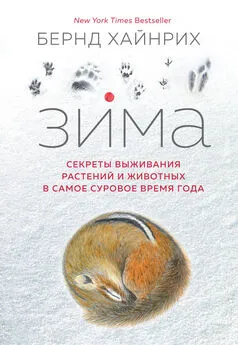
![Берндт Хайнрих - Зачем мы бежим, или Как догнать свою антилопу [Новый взгляд на эволюцию человека] [litres]](/books/1057566/berndt-hajnrih-zachem-my-bezhim-ili-kak-dognat-svo.webp)

